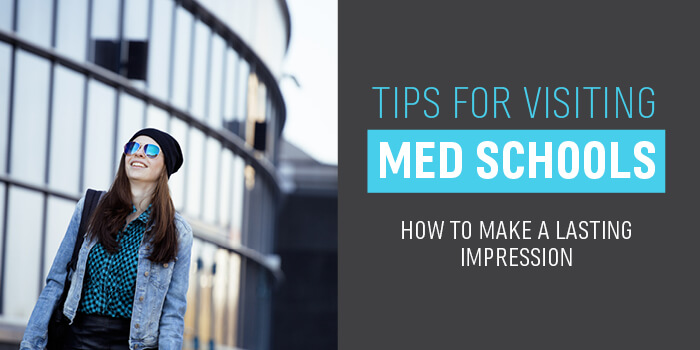Visiting Medical Schools: How to Make a Lasting Impression

This article is part of a series of tips about visiting medical schools. In this post we’ll share tips on what you can do to maximize your med school visits!!
Whether you have arranged a tour, are attending a premed fair, or have been invited to interview, making a memorable first impression can be the first step in establishing a long-term relationship with medical school representatives, students, and faculty.
Here are ten steps that will have you making a smashingly positive first impression.
1. Exercise regularly before your visit.
Exercise everyday or every other day leading up to your scheduled visit so that you won’t be too nervous to enjoy the experience. All that nervous energy has to come out somehow! Wouldn’t you rather decide where you get to expend it? I would. Work out—walk, run, do yoga – any kind of exercise will do, just make sure that some form of physical activity is part of your preparation. This strategy is especially important if you’re preparing for an interview, when nerves can impact performance.
2. Dress up.
When planning to visit a medical school for networking purposes, dress to impress. The adage, “The clothes make the (wo)man” remains true. Even when simply planning on taking an informational tour, wear business casual attire. For premed fairs and interviews, wear a suit. Demonstrate how much you care by taking the time to dress professionally.
3. Turn off your phone.
When visiting a campus, you never know who you’ll run into. If you’re staring down at your phone you may be sending out the signal that you’re not available to talk. If the Director of Admissions passes by, or even a medical student, you want to be available to say hi. The more people you can meet during your visit, the better. It will increase the chances that you will find an ally.
4. Breath mints.
Err on the side of caution for this one! There’s is nothing worse and more memorable – in a bad way – than halitosis. When in doubt, carry mints.
5. Make eye contact.
When uncertain whether you should introduce yourself or not, make eye contact. If the person is busy or unable to return eye contact, it may not be the best time to introduce yourself. If the person returns a steady gaze then it’s appropriate to say hello and introduce yourself. Pay attention to eye contact throughout the interaction. It can signal when you have lost your audience or when you should wrap up the conversation. More eye contact is good and demonstrates engagement, while less signals that it’s time to conclude the discussion. Obviously, too much eye contact can be creepy, so blink and relax your eyes and eyebrows from time to time. Don’t talk with your eyes!
6. Shake hands.
A firm, brief hand shake is the way to go! A hand shake that is too weak or too strong can send the wrong message. Knowing when to let go is also critical. However, some doctors may prefer not to shake hands during cold and flu season – so don’t take it personally.
7. Make a connection, when possible.
In our digital society, we often forget to ask other people about themselves. We’re all too busy taking selfies on Instagram! To make a connection, it’s necessary to demonstrate genuine interest in the person you are meeting for the first time. Give them your full attention, which is a sign of respect. Start small, with things like, “How is your day going?” If the conversation progresses, you can move up to bigger topics like, “What led to your decision to teach at [SCHOOL NAME]?” or “What do you like most about this campus?” Topics that can lead to a genuine connection can be anything from food and sports to research interests. The only way that you can find some interests that you may have in common is to ask questions and to listen to their responses. By responding thoughtfully, you will make a good impression, even if you don’t have a single thing in common.
8. Don’t try too hard.
A brief but positive interaction is far better than a long and awkward exchange. When in doubt, keep it short.
9. Thank the person for their time.
Ending the interaction on a positive note is critical. Concluding with gratitude is the safest way to ensure a successful conclusion. Some psychologists argue that gratitude is the most complex human emotion that we’re capable of expressing.
10. Offer the person a copy of your resume/CV or business card.
Bring updated copies of your resume or CV to share with whomever seems interested. You can also bring business cards, as described in our previous post, to make it even easier for the people you meet to follow up with you. (Stay tuned… In the next post in this series, I will cover what types of updates to highlight in your resume or CV.)
Reviewing these suggestions can help you present your best face in networking at medical schools. As our society becomes ever faster-paced, in keeping up with technology, it’s easy to forget the details or skip steps. Make an impression by demonstrating genuine interest in others. You just may make a few allies!
Do you need help creating an application that will help you stand out from the thousands of other medical school applicants? We’re here to help! Check out our Admissions Consulting Services for more information.
[xyz-ihs snippet=”Navigating-Med-Maze”]
[xyz-ihs snippet=”Signature-Code—Alicia”]
Related Resources:
• The Ultimate Guide to Medical School Interview Success
• Choosing the Best Medical Schools for YOU
• Numbers Aren’t Everything When You Choose Your Med Schools
